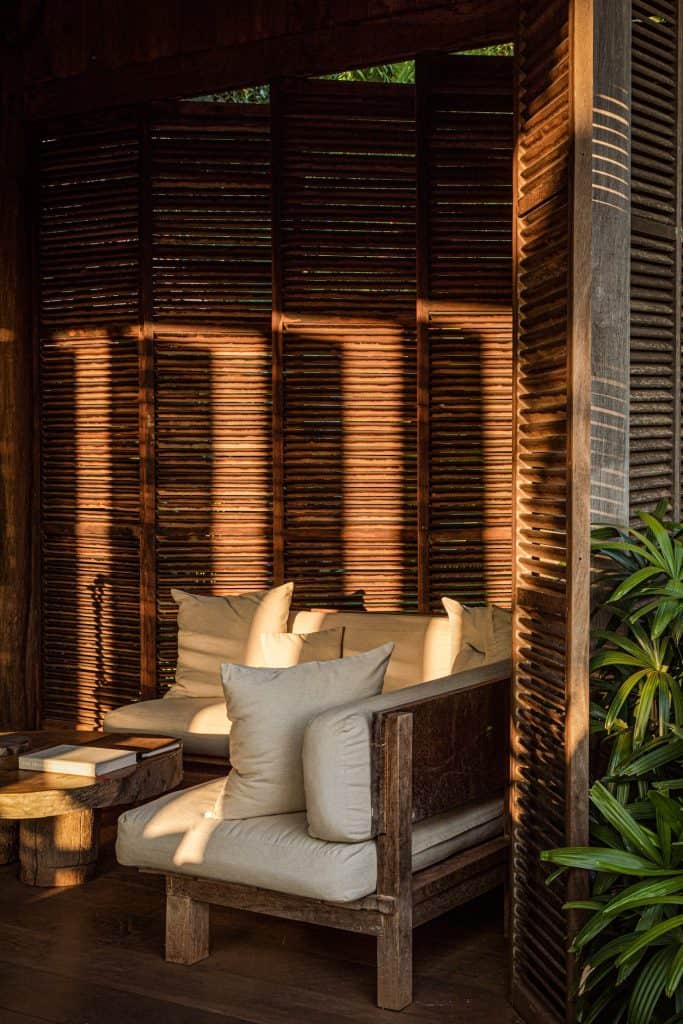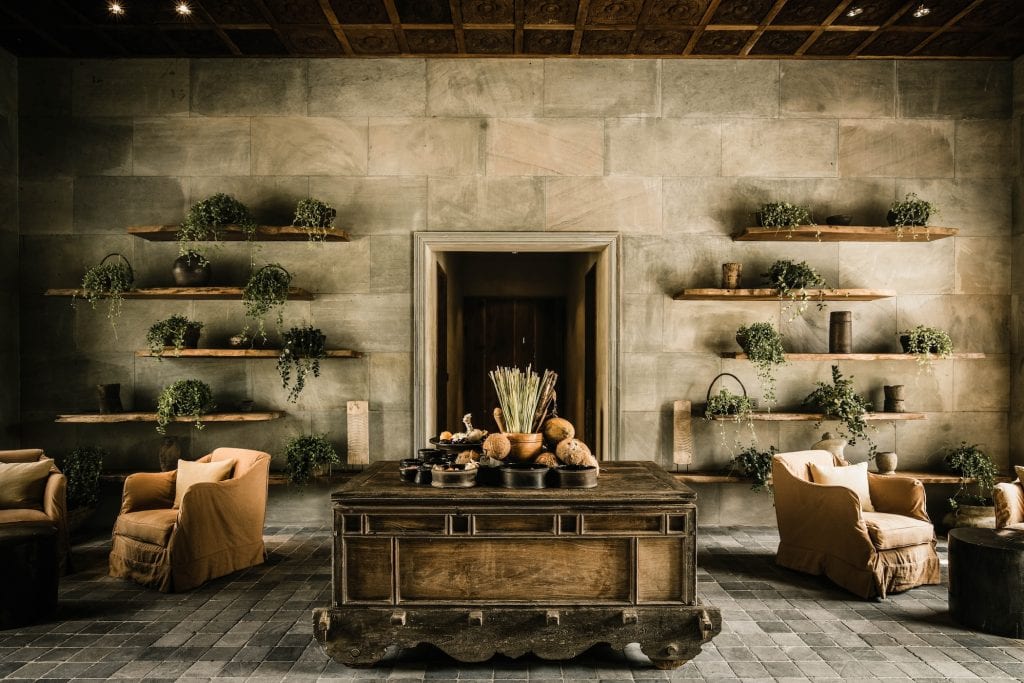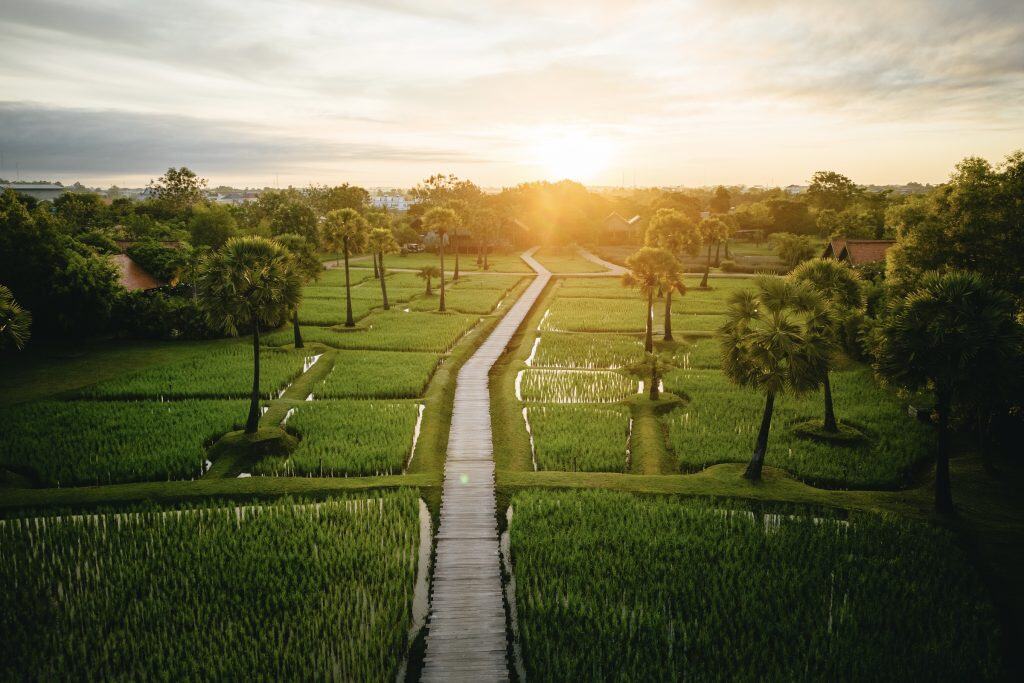Where to Sleep in Siem Reap.
These five hotels put Cambodian design, heritage and hospitality front and centre.
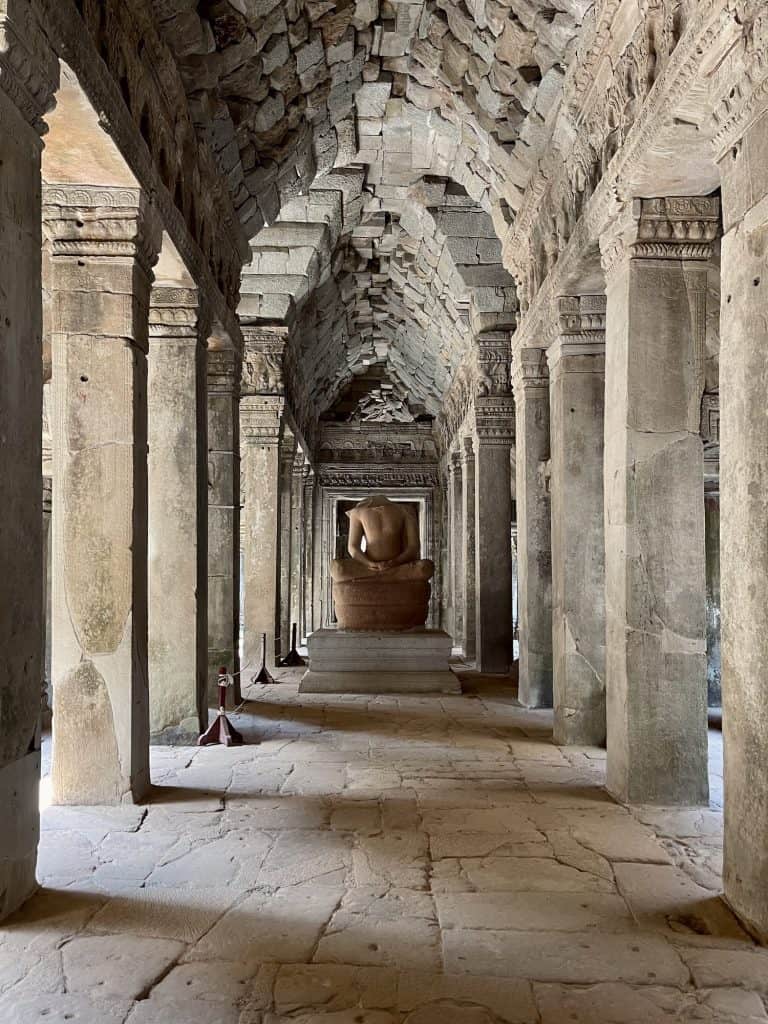
Cambodia shot to the top of my list of favourite countries last year, after a magical trip to Siem Reap. The gateway to Angkor, heartland of the Khmer Empire from the 9th to 15th century, I was there like everyone else to see the fabled Angkor Wat and as many crumbling temples that could be crammed into my two-week stay. Having read the books and listened to the podcasts—scenes in my mind of an acrobatic Angelina Jolie working her way through Ta Prohm Temple in Lara Croft: Tomb Raider—I knew I was in for a treat. What I wasn’t expecting was to fall for the town itself.
Siem Reap is not celebrated for its beauty like Ubud, Hoi An or Luang Prabang although it is incredibly charming, with a village-like feel, despite being Cambodia’s second largest city after Phnom Penh. At its centre is Old Market, surrounded by hundred-year-old shophouses and French colonial buildings overlooking the Siem Reap River. A straight canal a thousand years ago, when it was constructed during the heyday of the Khmer Empire, the waterway has since charted a more meandering course.
Today the riverbanks are lined in silk-cotton trees, strangler figs and shorea siamensis, a shady spot for cute hotels and cafes. Gilded peaks of Buddhist temples poke through palms and frangipani, alongside mid-century compounds, rustic bamboo lean-tos and a royal palace of humble but pretty proportions. For lovers of sculpture, the collection at Angkor National Museum is up there with anything you’ll see in Athens or Rome.
Shorea siamensis grows near shrines and pagodas as well as by the river. According to legend, an incarnation of the Buddha was born under a shorea siamensis tree. Faith is never far away in Siem Reap—a ‘thin place’ if Celtic philosophy is anything to go by—where the veil between heaven and earth is so narrow, the divine animates the everyday.
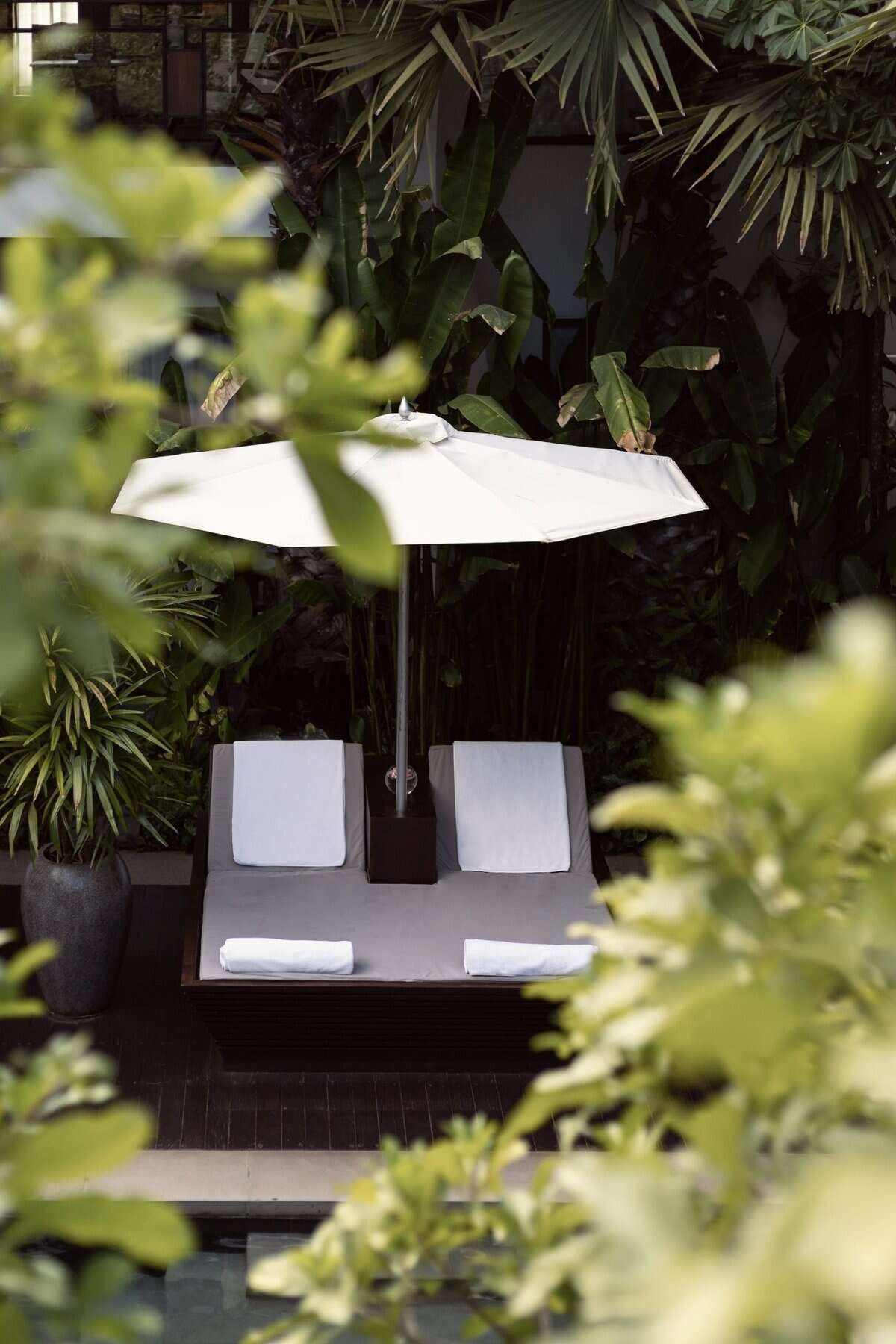
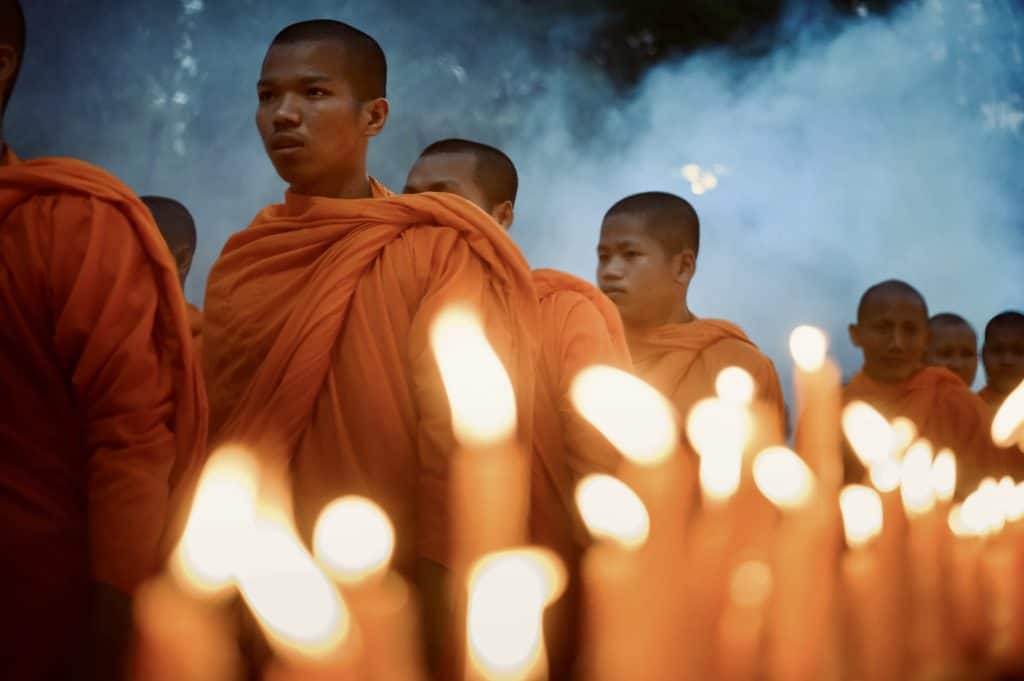
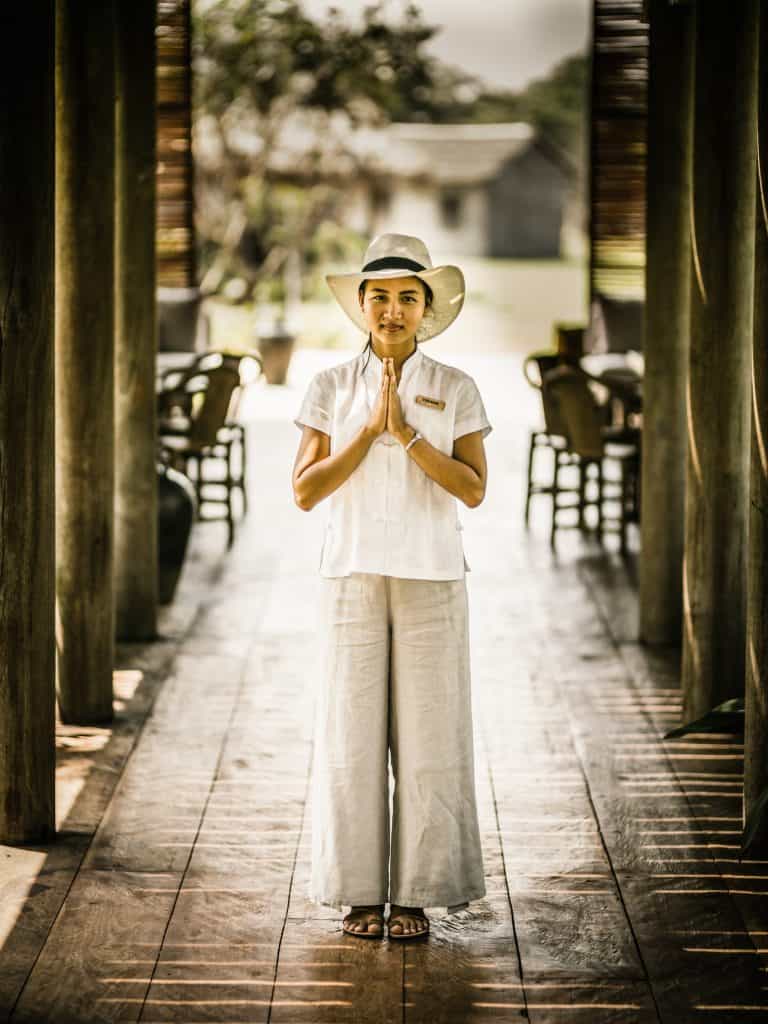
The Dalai Lama once said that if all children were taught to meditate in school, there would be no war. While Cambodia’s recent history has been nothing short of brutal, the beauty of its Buddhist culture and people have endured. It’s a place that stays with you. That changes you.
Most of the current generation do not have grandparents as a result of the genocide under the Khmer Rouge. As a result, Siem Reap is full of young people working hard to get ahead, determined to shape their lives and nation into something positive and meaningful. After eight weeks in Nepal in 2023, I never imagined meeting more warm and beautiful people than the Nepalese, but when a Cambodian smiles at you, it’s something else. Smiling is central to Cambodian culture, with an emphasis on politeness and respect.
Siem Reap has also struggled to bounce back since Covid, which means fewer crowds, lower prices and the satisfaction of knowing your money is being spent in a community that needs it. You’re spoilt for choice when it comes to accommodation, from backpacker joints to big-name corporate hotels, even a grand-dame palace from colonial times.
In between, a handful of stylish boutique hotels is putting Cambodian heritage and hospitality front and centre. Best of all, their environmental and community-focussed efforts are enriching the lives of the Cambodian people.

Jaya House River Park.
SCENE: An oasis of breezy pavilions, courtyards and tropical gardens, Jaya House River Park overlooks a verdant stretch of the Siem Reap River, close but not too close to the action around Old Market. It’s a short stroll along the river to the National Museum and just 10 minutes to the wonders of Angkor in one of Jaya’s complimentary tuk-tuks.
STYLE: Jaya House takes cues from Cambodian modernism, melding the country’s rich architectural heritage with mid-century flair after Cambodia gained independence from the French in the 1950’s. Interiors exude relaxed sophistication, blending monochromatic tones, stone and timber details, Art Deco furniture and Khmer sculpture. Portraits of Cambodian celebrities from the 1950’s and 60’s, some of whom did not survive the Khmer Rouge, cut striking profiles on Jaya’s walls, commissioned from the Small Art School that gives free art classes to underprivileged children.

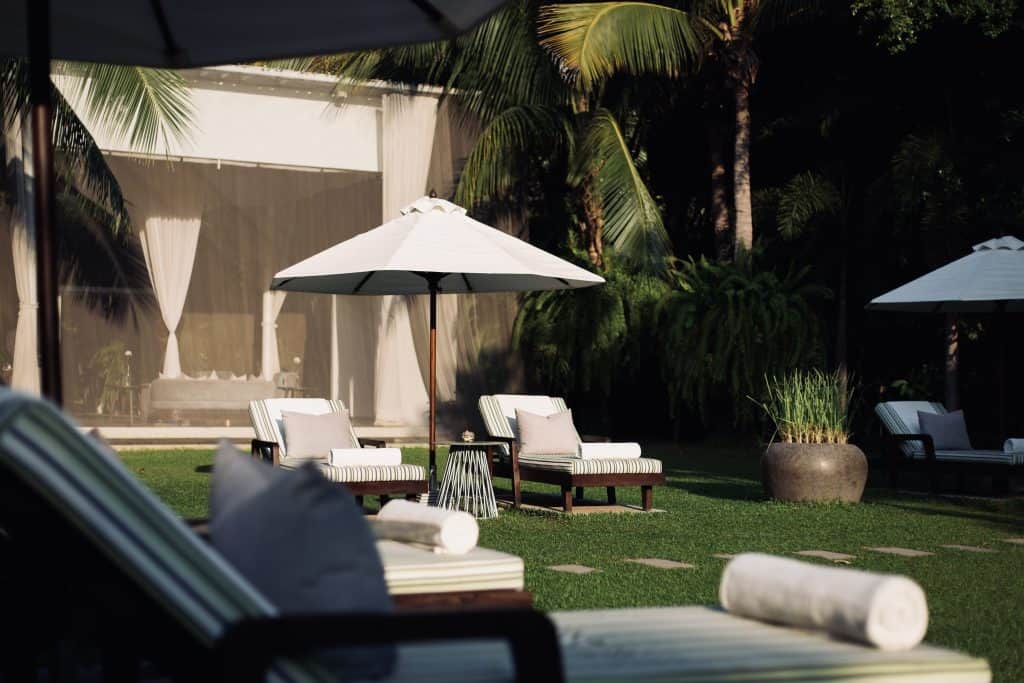
STORY: Managing Director Christian de Boer cut his teeth working for Richard Branson at Virgin before launching Jaya House in 2016. A tour de force on the Cambodian hospitality scene, his many green and community-focussed accolades include spearheading the Refill not Landfill global campaign and speaking at the UN on the importance of eliminating single-use plastic, after making Jaya House the first plastic-free hotel in Cambodia. He’s more host than hotel manager, meeting you upon arrival and checking in with you throughout your stay, as if welcoming a friend into his own home.
SUITES: White walls, silver textiles, mahogany and local stone make for a relaxing palette in Jaya’s 36 guest rooms, each with balcony or terrace and, according to the hotel’s website, the best beds in Siem Reap. They’re not wrong: you’d normally have to fork out the big bucks at Aman or Capella for such a sumptuous sleep. Whether you go for a Deluxe Room (38m2), Junior Suite (64m2) or Junior Pool Suites (90m2), you’re in for a generous stay. Beyond the usual—glass-bottled water, Malongo coffee machine with paper pods, robes, a pillow menu, bathroom products from Jaya Organics—you’ll enjoy complimentary mini bar and laundry, a 60-minute spa treatment per person per day, private airport transfers and a fleet of smart-looking tuk-tuks at the front of the hotel, ready to whisk you around town.
SPACES: From the salon-like lobby to Trorkuon Khmer restaurant, gorgeous tropical gardens and two swimming pools—one in a shady courtyard, the other clad in silver mosaic tiles on the lawn—Jaya packs a lot into a small space. The rooftop Skybar is perfect for a ginger mojito, great hornbills bouncing across the canopy of trees along the river as the sun sets. Therapists at River Park Spa calm and restore using ancient Khmer traditions and the extensive range of locally made Jaya Organics, antioxidant-rich Moringa being the hero ingredient.
SERVICE: My first taste of Cambodian hospitality was at Jaya House. It set the bar high for the competition, although I soon realised warm and generous hospitality is what Cambodians do best. In either case Jaya stands out from the pack. Happy staff make for happy guests, and Jaya’s crew wear their smile as a badge of honour. Together with the hotel’s generous inclusions, it’s easy to see why Jaya is not only Cambodia’s no.1 hotel on Tripadvisor, but one of the top-ranked hotels in the world.

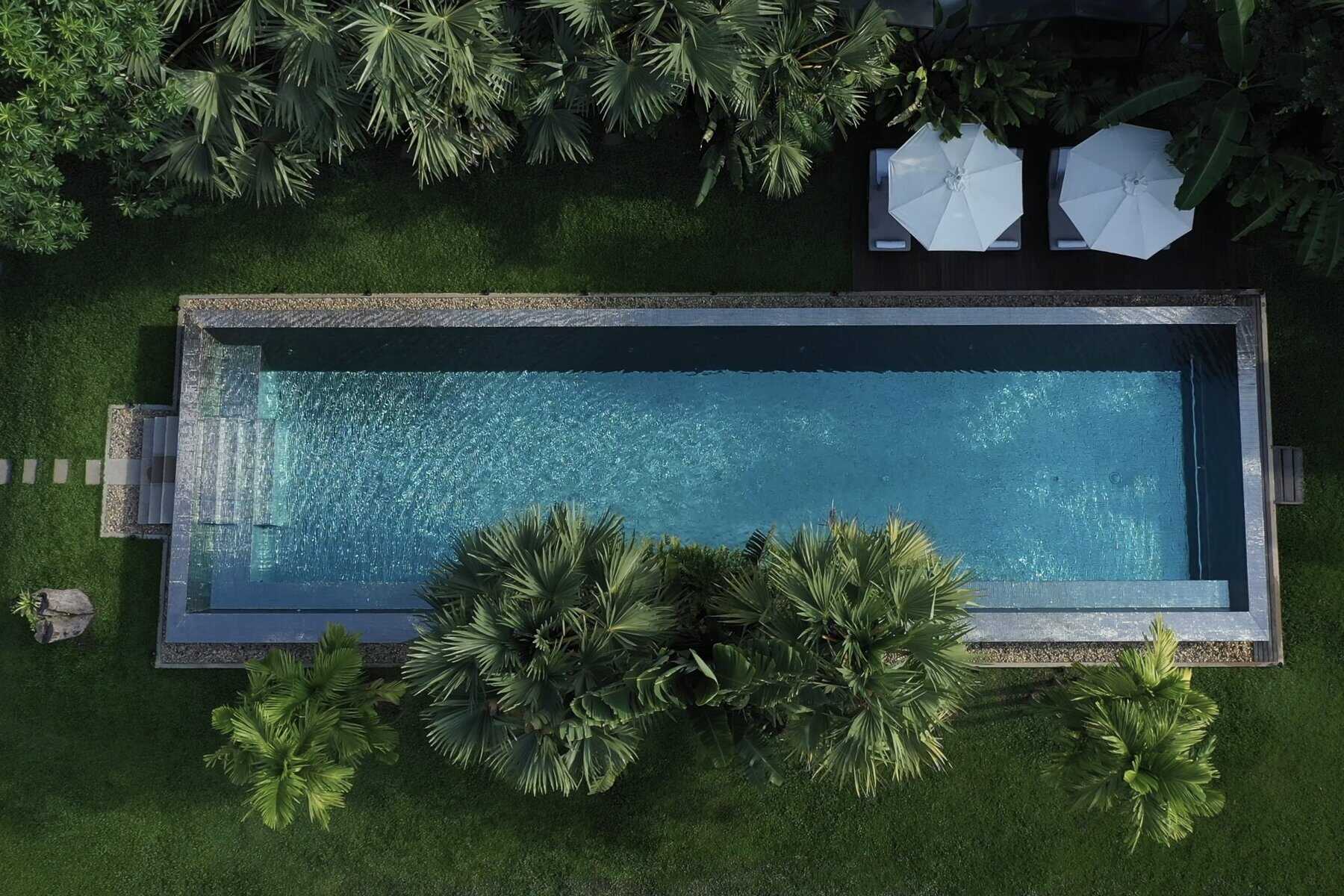

SUSTAINABILITY: De Boer’s Refill Not Landfill campaign to reduce single-use plastic proved so successful when it was launched in 2016—a QR code on reusable stainless-steel bottles guides the user to nearby refill stations—it expanded into 19 countries, including Thailand, Sri Lanka, Vietnam and New Zealand. Since its launch, the 36-room hotel has prevented more than 500,000 plastic bottles from ending up in landfill or the ocean. It uses glass bottles, paper and linen bags and only works with plastic-free suppliers. Staff are not only employed full time and receive a quality hospitality education and healthcare, the hotel supports a host of local initiatives, including Green Gecko Centre for Street Children, Cambodia Rural Students Trust and the Cambodian Landmine Museum. Jaya has also planted more than 3,000 trees along the riverfront—much to the delight of those great hornbills—and runs the Nutritional Book Drive, whereby guests bring books in their suitcase that De Boer and his team distribute to local children
SPEND: Deluxe Rooms from USD290/night.
Smiling is central to Cambodian culture, with an emphasis on politeness and respect.
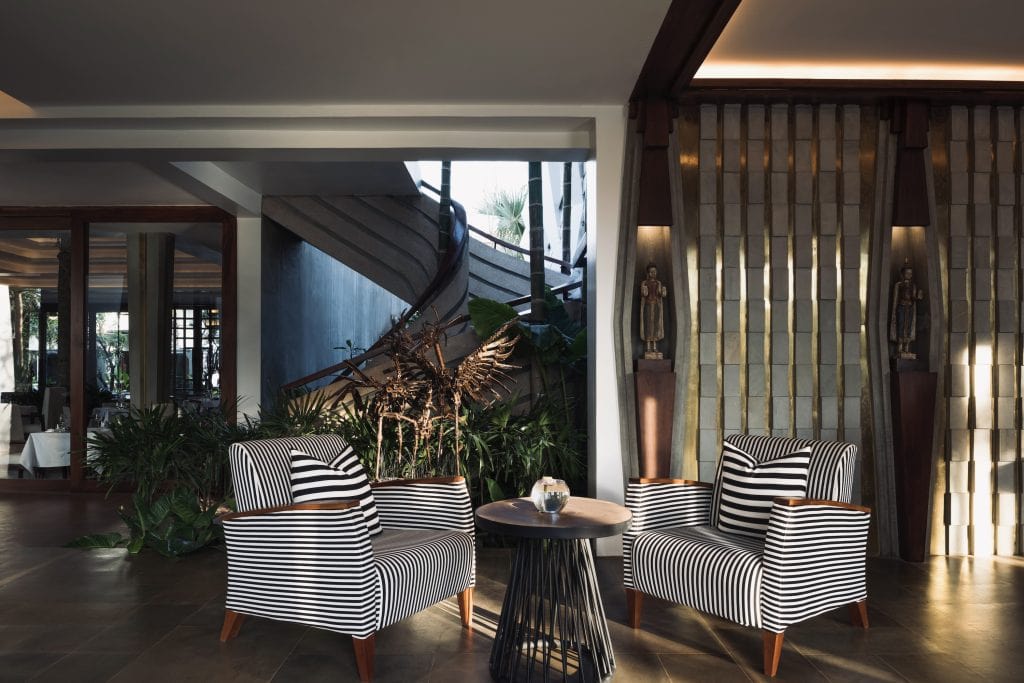
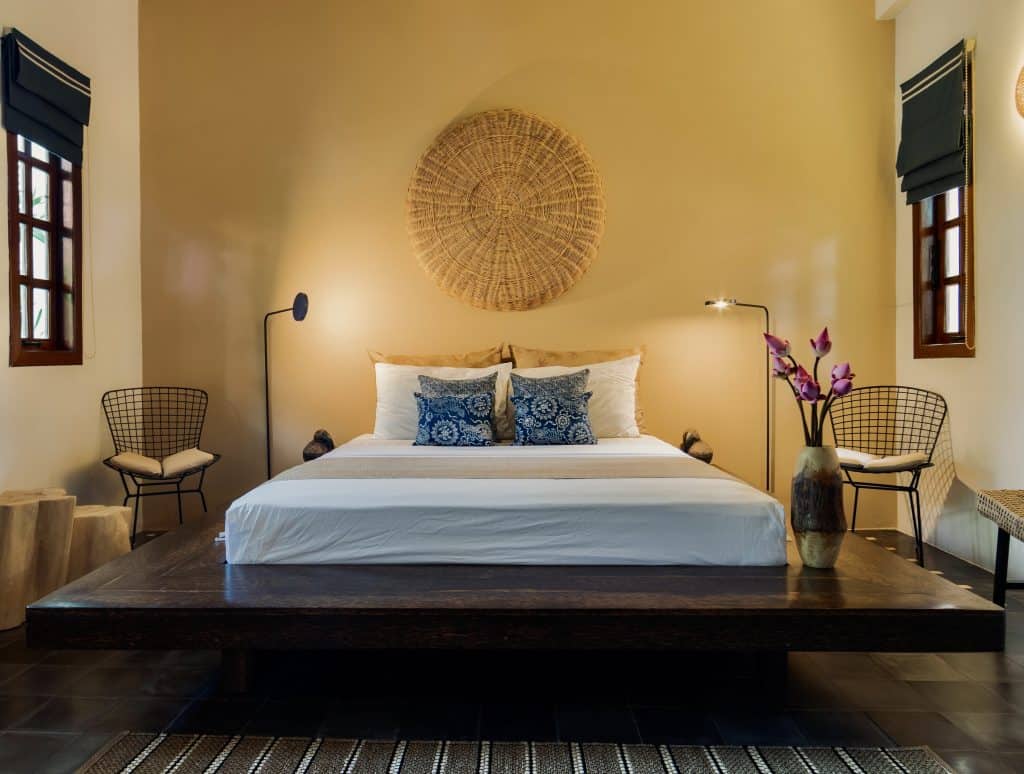
Rambutan.
SCENE: Tucked away at the end of a lane amongst jasmine, poinciana and frangipani, the cosy feel of Rambutan belies its location, smack bang in the centre of Siem Reap. It’s a five-minute walk to Old Market in one direction, and the same to Cuisine Wat Damnak in the other, a stellar restaurant taking its name from the nearby Buddhist temple, Wat Damnak. The property comprises two adjoining wings—hotel and resort, each as charming as the other—as well as architecturally striking apartments for longer stays.
STYLE: Raised off the ground in rendered brick around courtyards with saltwater swimming pools, Rambutan oozes vintage tropical style. Terracotta roof tiles are shaped like the scales of a snake, the heads of mythical Nagas (semi-divine human-serpents in Hindu and Buddhist mythology) at each corner. An open-air reception sets the property’s relaxed tone, with Kentia palms and 60’s Danish armchairs on coloured-cement tiles—simplified versions of those introduced to Cambodia during the French protectorate. It’s simple but packed with style, including handmade furniture, Khmer textiles and punchy local art.
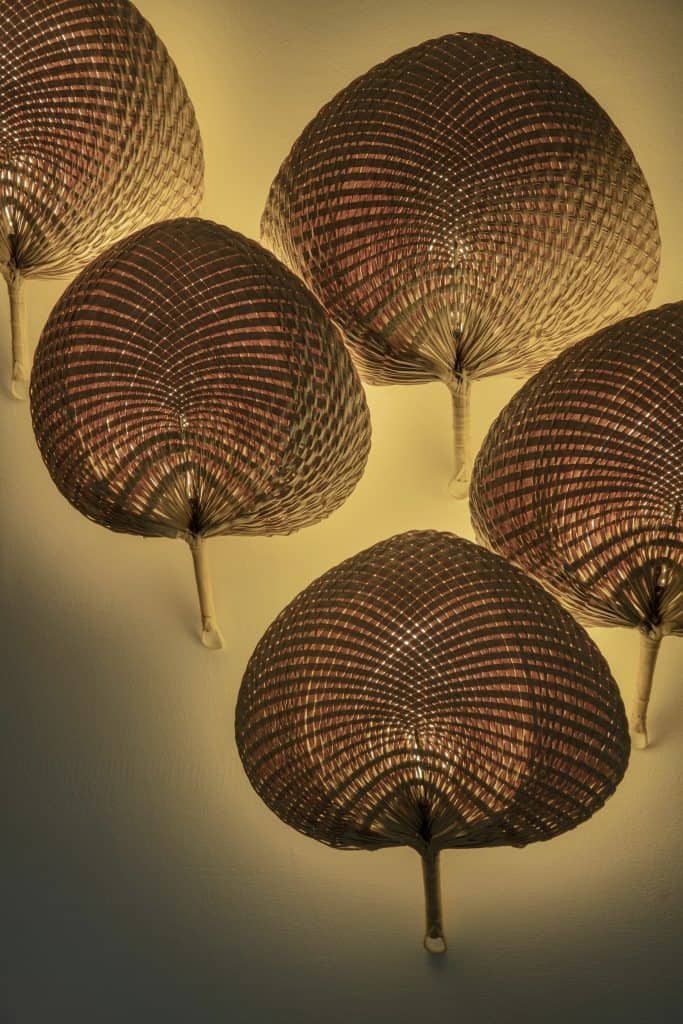
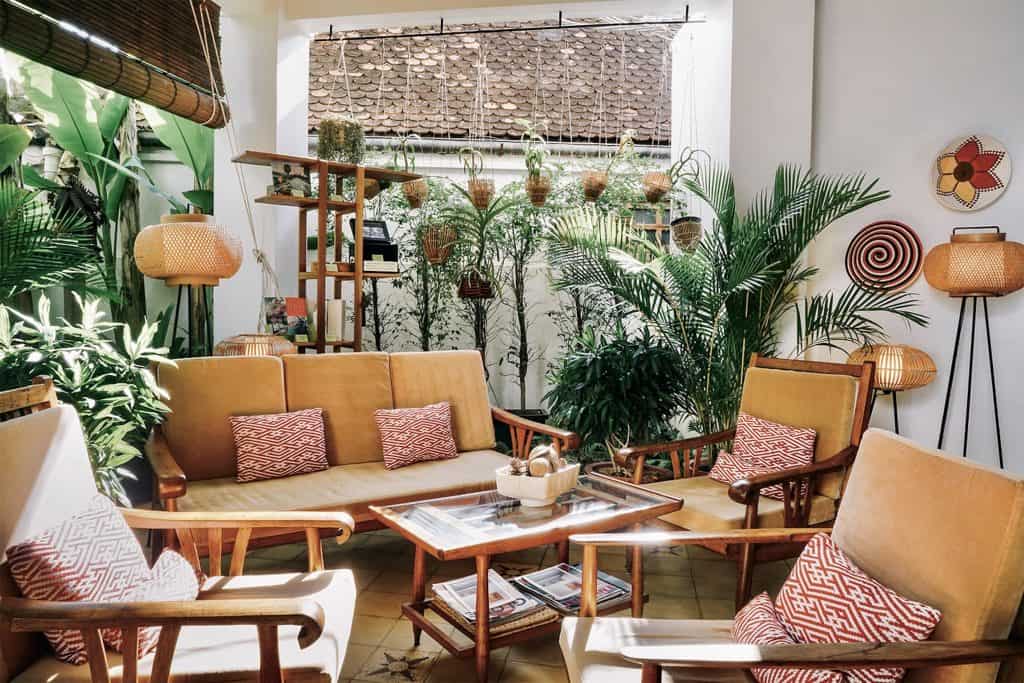
STORY: Punnavit ‘Tum’ Hantitipart was living in Sydney, while Dirk de Graaff had just finished a project in Hong Kong and was looking for a new challenge. They met on holiday in Bangkok in 2005 and reconnected in Siem Reap the following year. At the time, the property stood on a sand road with a large pond, home to an army of frogs and grazing water buffalo. They built the hotel from the ground up, envisaging a welcoming and inclusive space that reflected everything they loved about Cambodian culture. A word-of-mouth hit from day one, Rambutan was the first LGBTQ+ friendly boutique hotel in Siem Reap.
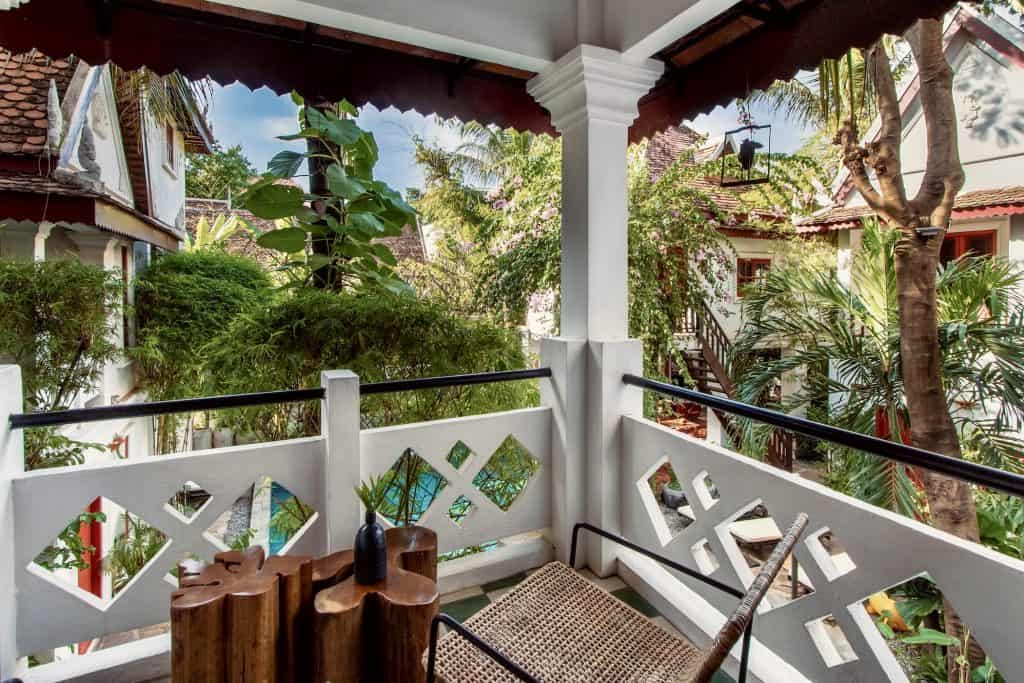
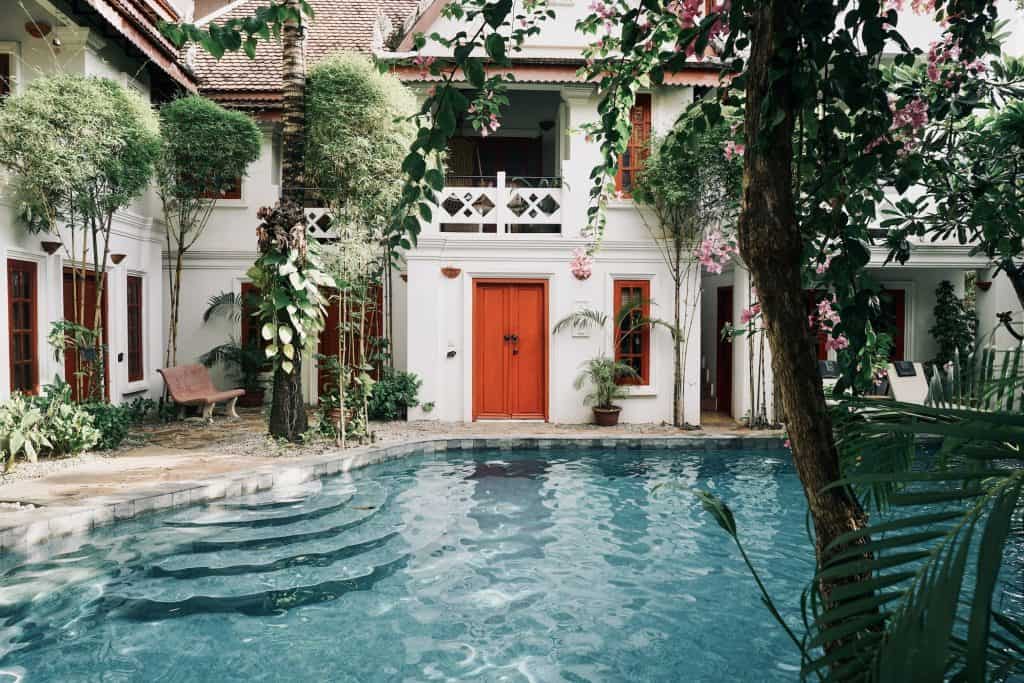
SUITES: Rambutan’s 24 guest rooms channel a bohemian spirit, with cane blinds, hand-woven textiles and walls hung with collections of vintage rattan rice trays. Balcony Villas (36m2) are split over two levels—bedroom and bathroom downstairs, living room and balcony above—super charming with chequerboard floors and vermillion-painted doors and shutters. Deluxe Terraces (40m2) and Deluxe Rooftops (72m2) also feature private outdoor soaking tubs. In contrast Rambutan’s five Urban Residences have more of an industrial feel, with open-plan kitchens, modern sofas, cantilevered staircases and air bridges to loft bedrooms—the perfect pads for more immersive stays in Siem Reap.
SPACES: Life revolves around two courtyards—one at the hotel and another at the resort—each with its own saltwater pool. There’s an open-air restaurant and a bar for cocktails with a tropical twist, as well as a massage pavilion and quiet corners of the shady garden, perfect for unwinding with a book.
SERVICE: Much of the tight-knit team attended local NGO hospitality schools, often from underprivileged rural backgrounds. Some have been with the hotel for more than a decade. I got chatting to a school teacher from Singapore at the bar one evening, a regular who returns to spend a week at the resort every year. She returns not for the temples but for daily massage with the same woman around the corner, and for the reception she receives at Rambutan, welcomed back by familiar faces who not only remember her name and stories but go above and beyond to provide a memorable stay. Tum and Dirk run a scholarship programme for staff, their children and family members, who pursue careers in tourism as well as law, finance and IT, from kindergarten to master’s degrees. Another case of happy staff, happy guests.

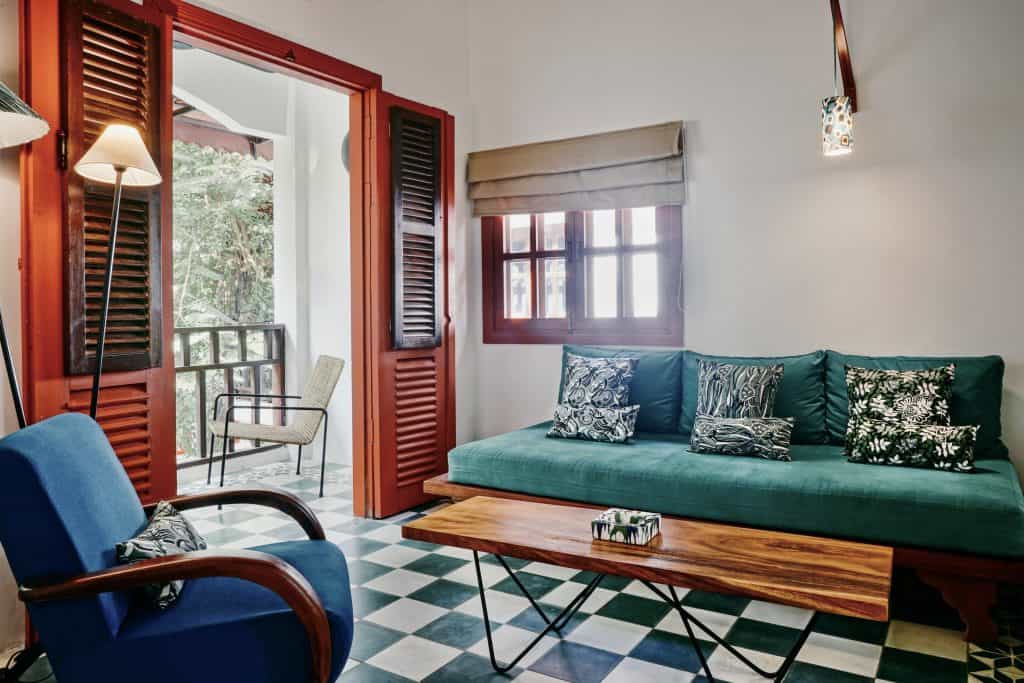
SUSTAINABILITY: From organic local produce, homewares sourced from recycled and upcycled materials, compostable packaging, cooking oil recycled as biodiesel and solar-powered hot water—the crew also rolling up their sleeves twice a year to participate in local city clean-up initiatives—Rambutan gets it right.
SPEND: Rooms from USD50/night, Urban Residences from USD150/night.
Shinta Mani Angkor.
SCENE: Shinta Mani Angkor sits between Old Market and Royal Independence Gardens in the leafy French Quarter of Siem Reap. The work of Bangkok-based American designer Bill Bensley, the property unfolds in a series of courtyards, colonnades and stunning perspectives, much like its fabled namesake, Angkor Wat. Ten Bensley Collection Pool Villas are the jewel in the crown—a hotel within a hotel accessed through a secret garden, home to the most glamorous digs in town.
STYLE: If you’re familiar with Bensley’s theatrical brushstroke you’ll recognise his signature black-and-white palette in an instant, highlighting detail and texture across the design of Shinta Mani. Rectangular columns, high-pitched roofs and recessed doorways reference the architecture of Khmer temples, while ochre and saffron textiles recall the robes of Buddhist monks. With their striped lap pools and lavish bedroom pavilions, the Pool Villas are especially seductive. Think brass inlay in dark-wood floors, monumental bas-relief emulating the rippling robes of Khmer kings and golden etageres either side of cloud-like beds, glistening like the peaks of nearby pagodas.
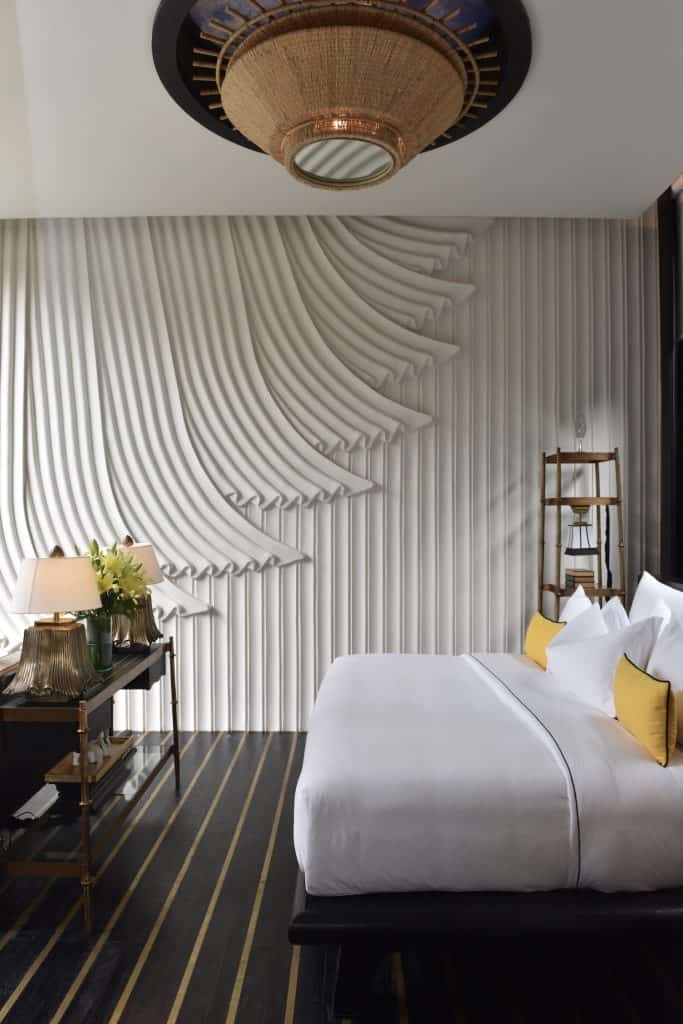
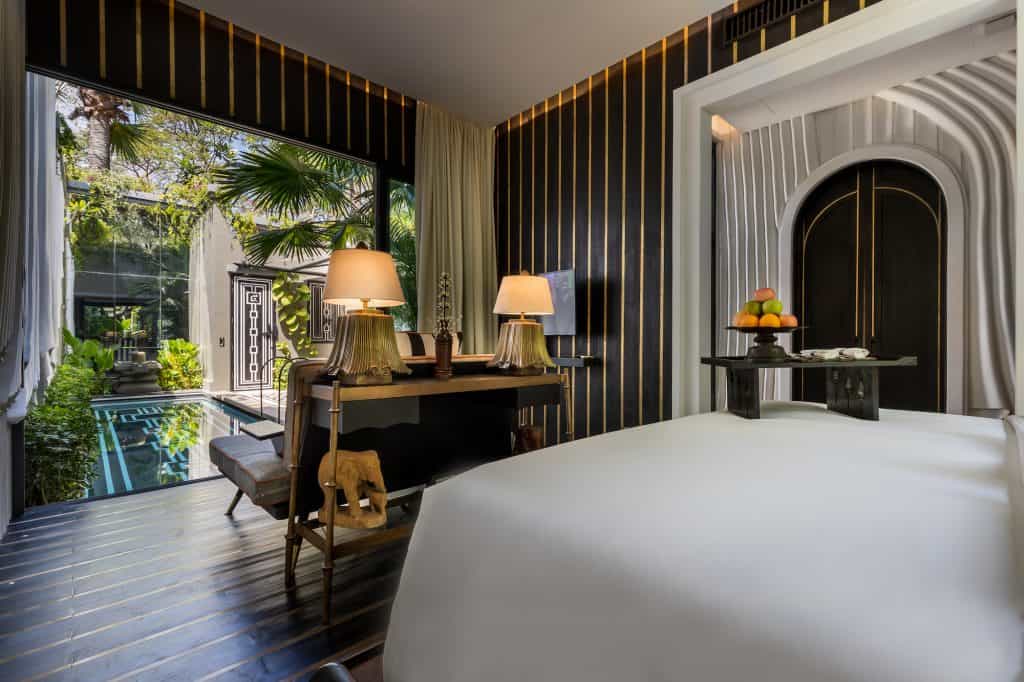
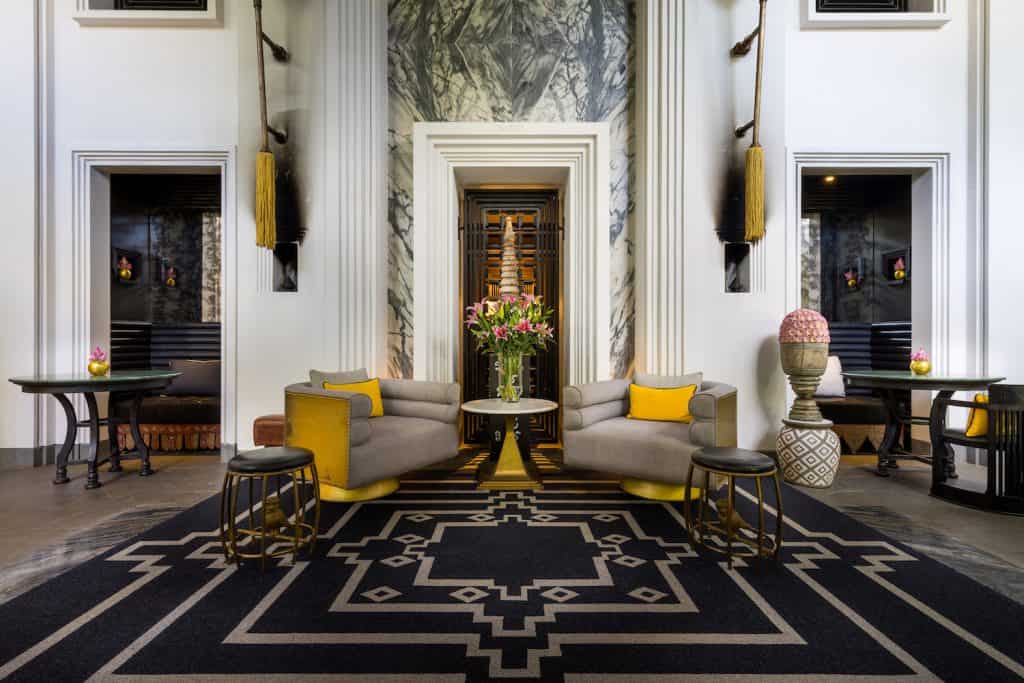
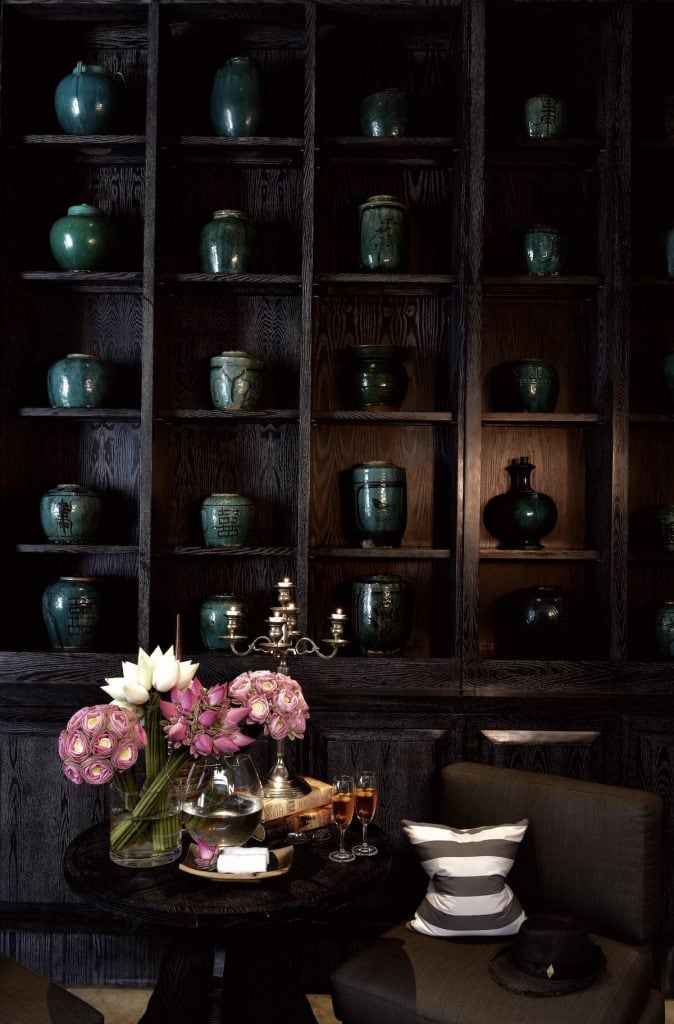
STORY: Shinta Mani—good heart in Sanskrit—was launched by Soukoun Chanpreda in 2004 as an 18-room guesthouse and hospitality school where underprivileged youths could learn the hotel trade. Bensley came on board in 2012, renovating and extending the original guesthouse into the sumptuous spread it is today. Six years later, they snapped up 300 hectares in the Cardamom Mountains and created the luxury tented retreat, Shinta Mani Wild, saving the wildlife-packed tract from loggers and poachers. Shinta Mani Mustang in Nepal came in 2023. All three properties are embedded in the DNA of the Shinta Mani Foundation, with 100% of donations and a percentage of all hotel revenue going to the non-profit.
SUITES: 105 guest rooms are spread across three distinct but interconnected wings: Bayon, Angkor and the Pool Villas. Bayon Rooms (42m2) are kitted out in forged-iron beds and punchy black furniture, with balconies overlooking a large courtyard garden and 23-metre pool in striking black-and-white stripes. Junior Suites (78m2) come with a separate living room, while Executive Suites (94m2) are packed with antiques and art—wunderkammers of Bensley’s eclectic style—alongside oversized bathrooms with freestanding tubs. Tucked across the street, rooms in the Angkor Wing (36-45m2) have more of a contemporary feel, with custom furniture, terrazzo bathrooms and black-and-white photographs of the temples by Martin Reeves. If the budget allows, go for a Pool Villa (156m2). Havens of indoor-outdoor living, each features a 9-metre lap pool, lavish bedroom and marble bathroom with outdoor stone tub, not to mention an army of Bensley Butlers to attend to every whim.
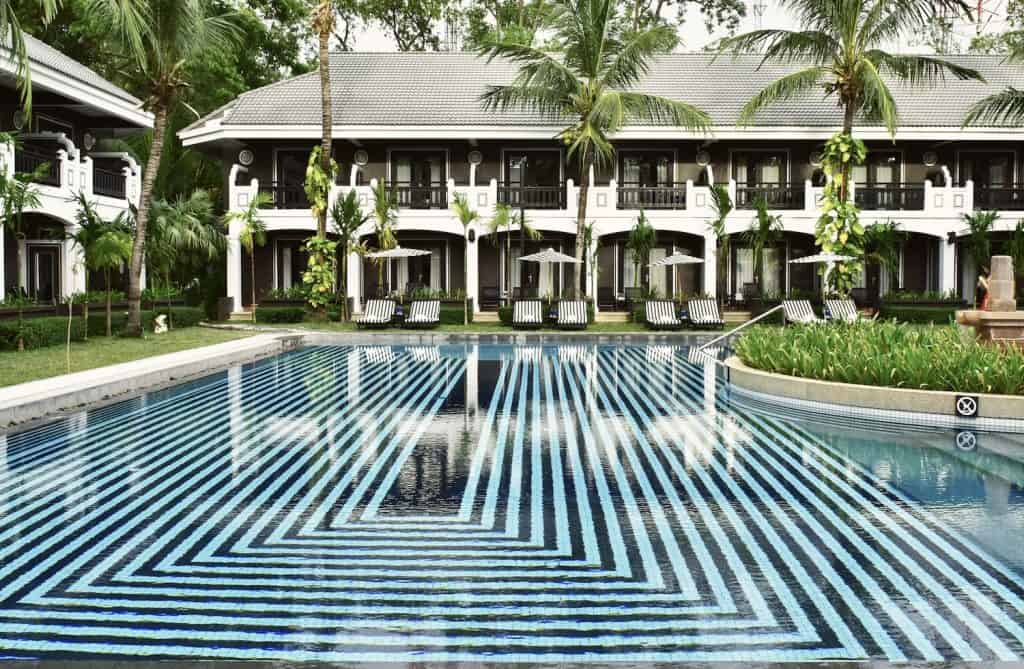
SPACES: Both wings are centred around swimming pools, each with a poolside bar. The Bayon Wing is also home to restaurant Baitong, for Khmer street food and international fare. There’s a spa and fitness centre across the street in the Angkor Wing, alongside Kroya, where Chef Chanrith fuses nostalgic Cambodian flavours with gourmet flair in smart surroundings. I bought the best pair of espadrilles at Outsider, Shinta Mani’s boutique/gallery, where you can also score paintings by Bill Bensley—all sales directly benefiting the Shinta Mani Foundation. When the shopping is done, head to the Bensley Bar, where Solin makes a mean Margarita.
SERVICE: Ensconced in my pool villa with the Bensley Butlers on call day and night, my experience was as good as it gets—although service throughout the hotel was wonderful. Chat with the warm and friendly staff and you’ll get a real sense of the connection between the school, the hotel, and Cambodian hospitality in general.
SUSTAINABILITY: Since its inception, hundreds of Khmer students from disadvantaged backgrounds have graduated from Shinta Mani’s hospitality school, receiving free tuition as well as uniforms, materials, meals, a stipend and housing as needed. From this came the foundation, which has financed the construction of thousands of homes and wells as well as providing water filters—a big deal as two million Cambodian lack access to clean water—and micro loans, helping individuals, families and whole communities escape the cycle of poverty. Outsider boutique showcases locally made artisan wares—often next to a photo of the person who made them—and the hotel is of course plastic free.
SPEND: Rooms from USD150/night, Suites from USD270/night and Pool Villas from USD740/night.

FCC Angkor by Avani.
SCENE: Most hotels in Siem Reap are hidden behind walls. Not FCC Angkor by Avani. Neighbouring the Royal Residence on a pretty stretch of the river in the French Quarter, FCC’s sleek pavilions and lush tropical gardens are open plan to the streetscape, making this 80-room boutique hotel one of the most inviting in town. A perfect location too, five minutes from Old Market and 15 minutes in a tuk-tuk to Angkor Wat.
STYLE: If you came across FCC in modernist enclaves like Palm Springs or Rio, it wouldn’t look out of place. The hotel is equally at home in Siem Reap—in fact, it’s somewhere like FCC that you realise just how well modernism works in the tropics. Low-lying wings and breezy pavilions stretch out horizontally, anchoring the white-washed property in its verdant surrounds. Minimalist interiors and exterior spaces are united in their neutral palette, warmed with cane, hardwood furniture and rich timber detailing. Terracotta-hued brick paths cut through explosively verdant gardens, a storied mid-century villa at the centre of the property.
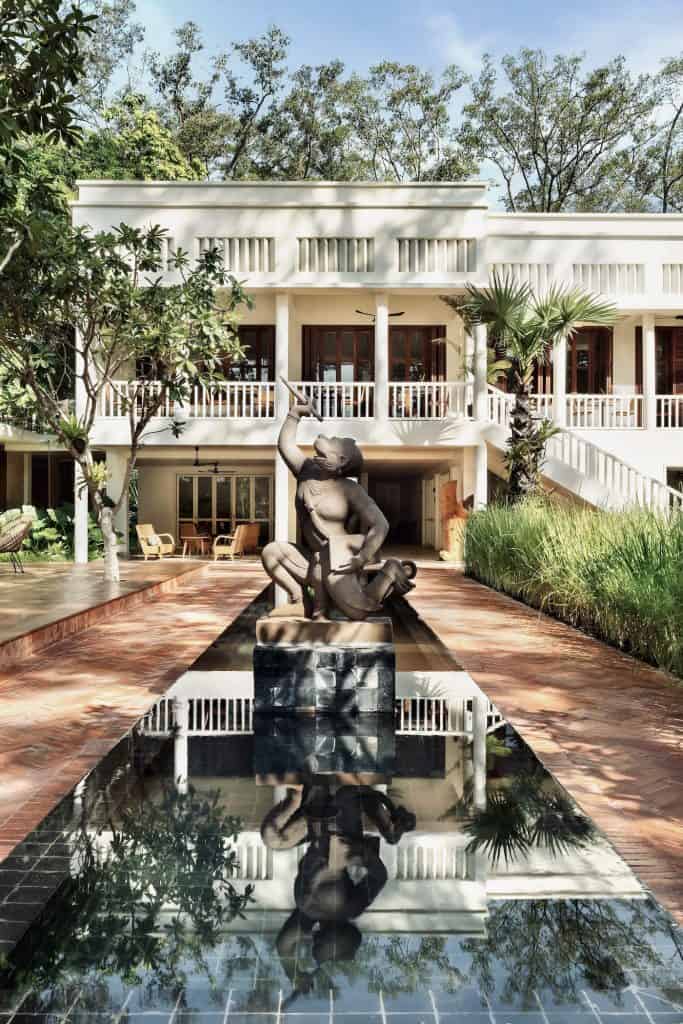
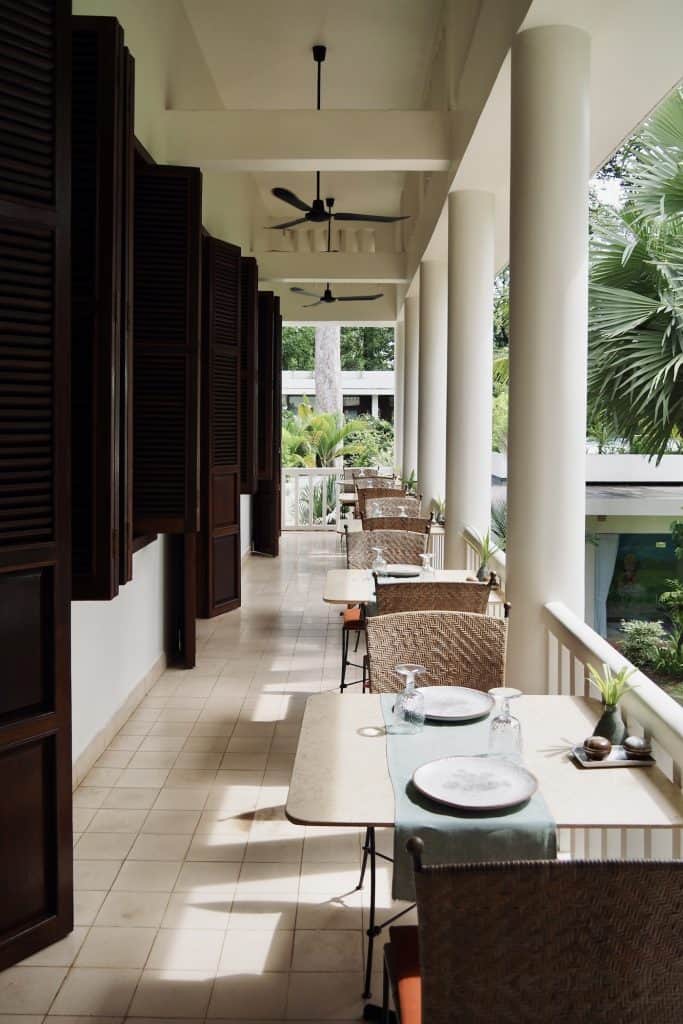
STORY: While it may not have been the actual Foreign Correspondents Club, located in Phnom Penh, the villa was constructed in the early 1950’s as the residence of the French Governor of Siem Reap, giving FCC Angkor more than a dash of 20th century cachet. When Cambodia achieved independence and the governor got the boot in 1953, it then became the residence of the French Consul General. In either case, sitting on the villa’s long veranda, it’s easy to imagine journalists and adventurers passing through the property, trading stories back in the day. It then came under the wing of Avani Hotels & Resorts, a marque adept at reimagining places with provenance. Avani’s Luang Prabang hotel was built by Aman’s Adrian Zecha, while Bentota was designed by the Sri Lankan architect, Geoffrey Bawa. Their 2019 renovation and expansion of the Siem Reap property channels its legend with similar finesse.
SUITES: Accomodation is tucked behind the governor’s villa, where rooms and suites overlook a courtyard or marble-tiled lap pool. The Deluxe Room (33m2) is compact but well formed, with a sleek bed and desk in rain tree wood, great lighting and bathroom decked out in concrete tiles and copper. Suites are considerably more expansive (66-149m2), with timber floors, smart white sofas and freestanding tubs. In a new wing across the street, plush Premier Rooms (38m2) overlook FCC’s second marble swimming pool. All rooms come with a balcony or terrace, as well as supremely comfortable beds dressed in handwoven textiles, earthy Khmer artefacts and the coolest coffee maker in town (more on that below). Vintage typewriters recall the journalistic spirit of the Foreign Correspondents Club.

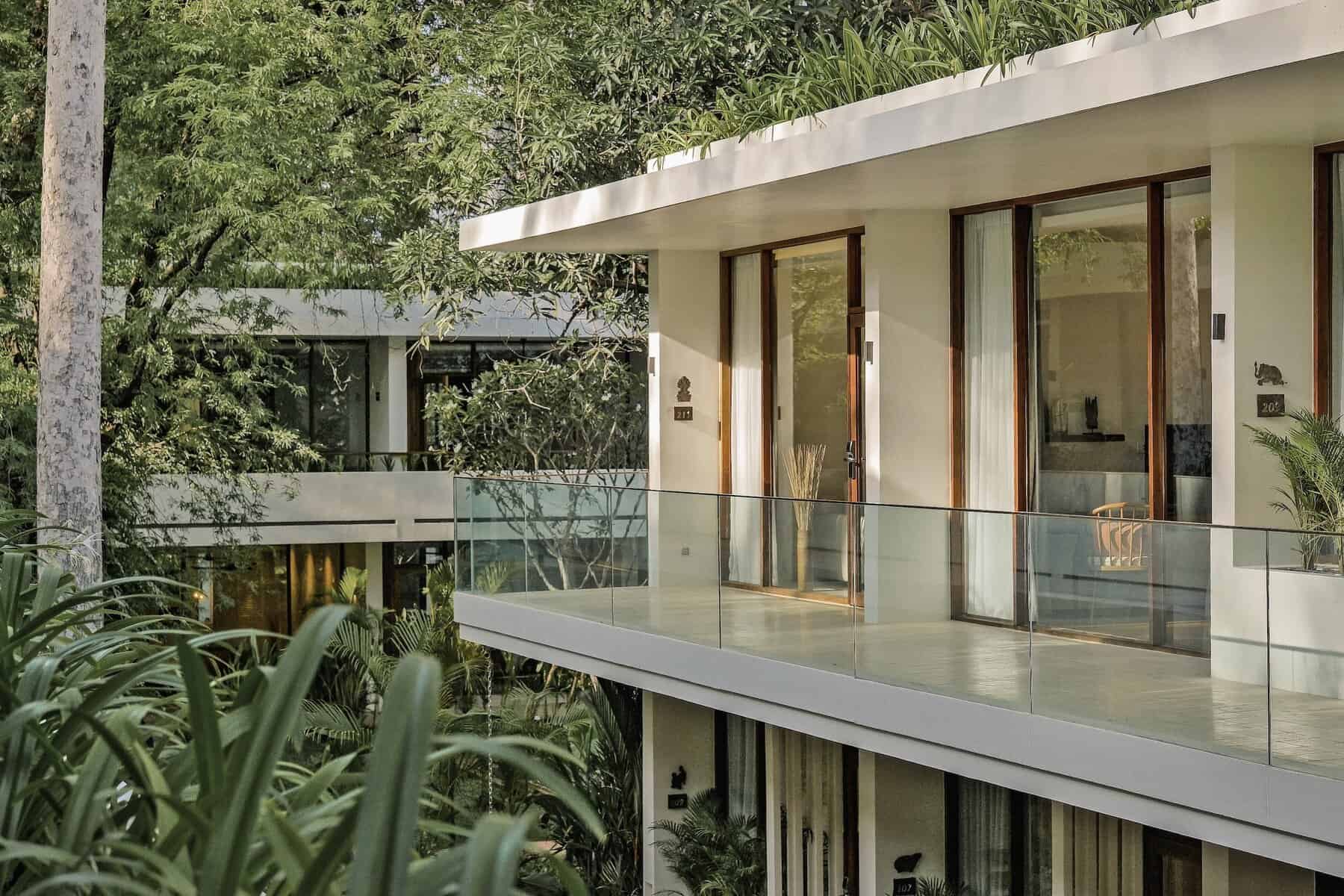
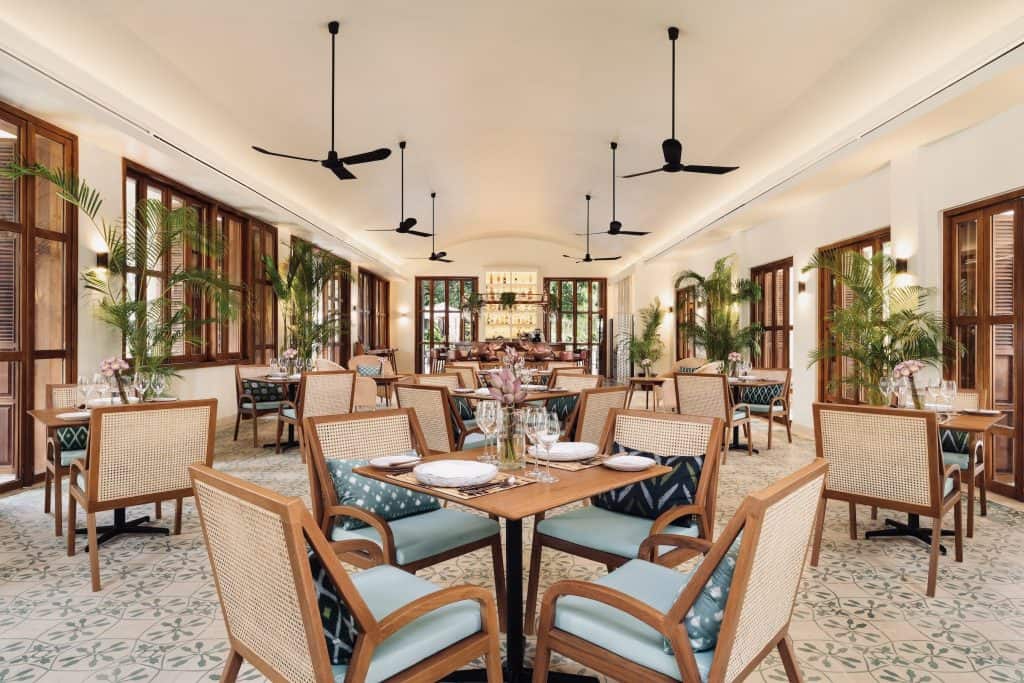
SPACES: Kick start the morning with breakfast on the veranda at The Mansion, FCC’s dashing restaurant on the upper floor of the governor’s villa, crêpes one day, spicy Khmer rice noodle soup the next. Return in the evening for a top-notch wine list and refined Cambodian fare. Head downstairs to the Botanical Tasting Room for exotic local spirits—cassava vodka with lime leaf and lemongrass gin, amongst others—alongside cocktail bar Scribe, perfect for people watching. After a day exploring the delights of Angkor, hit Visaya Spa for a traditional Khmer massage. Was the best I had in Siem Reap.
SERVICE: Relaxed and efficient service across the board. FCC’s staff are super friendly and full of personality, a mix of French, Polish, Moroccan and Cambodian, many of whom felt like friends by the end of my stay. They go out of their way to make your stay memorable. A highlight was when they connected me with Adventures Cambodia, where Benoit and his wife Akim, who was raised at Angkor Wat, do cool tours of the temples by 1960’s army jeep or Vespa, allowing for a more off-the-beaten-path experience.
SPEND: Deluxe Rooms from USD182/night, Suites from USD241/night.
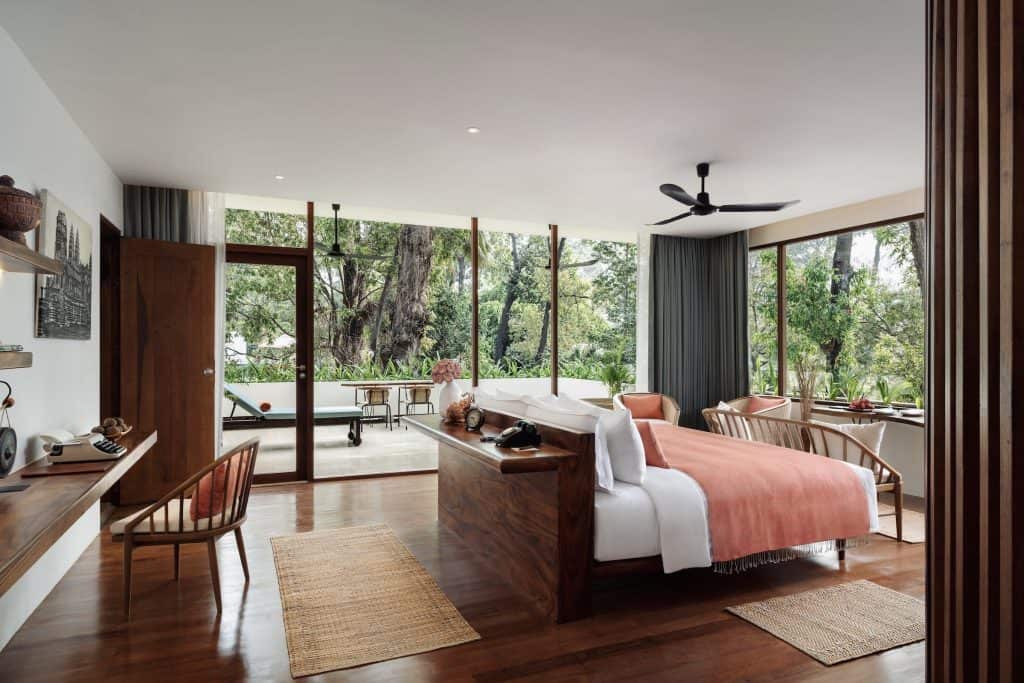

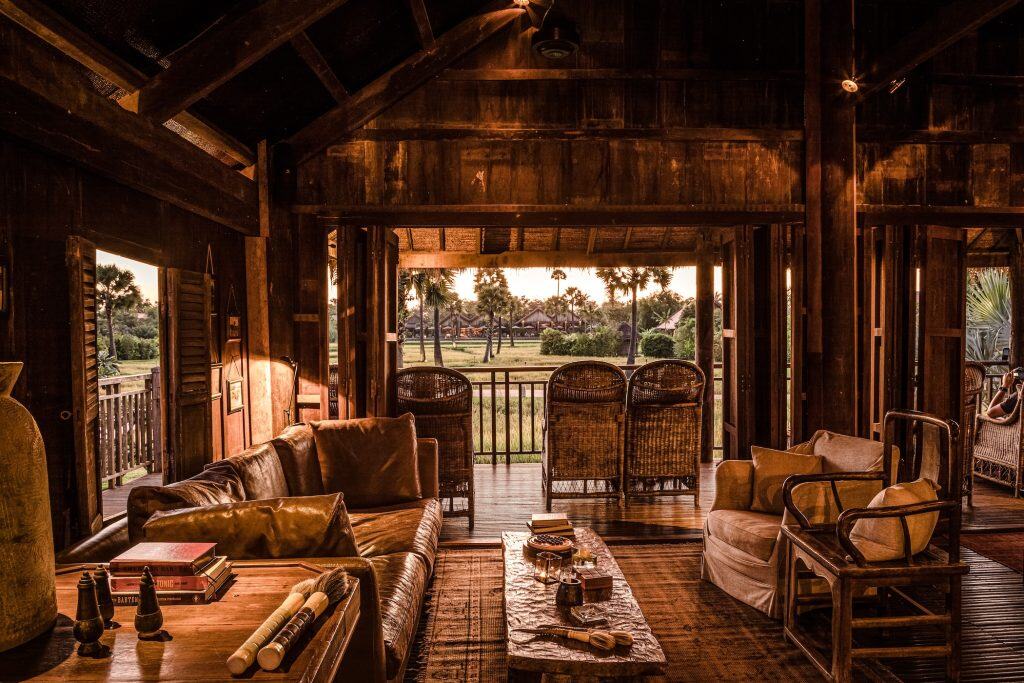
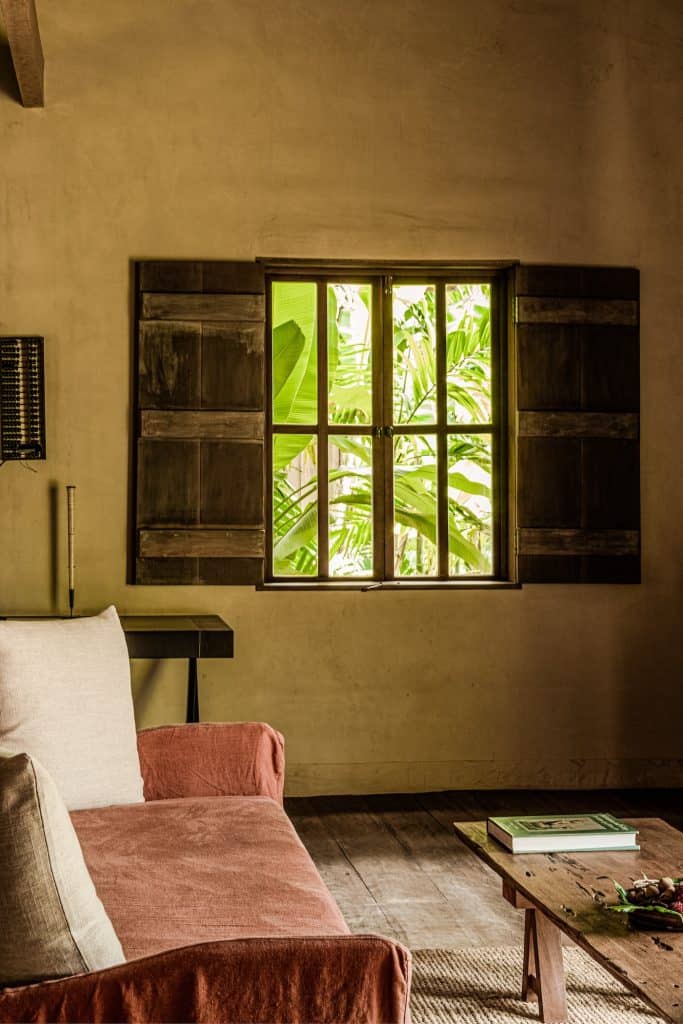
Zannier Phum Baitang.
SCENE: Picture a setting of thatched-roof stilt houses amongst rice paddy fields and palm trees, the scent of lemongrass on the breeze, a family of water buffalo grazing nearby. Add to this bucolic scene a temple-like spa, 50-metre infinity pool and a barman who knows how to make the perfect G&T—the stilt houses home to the most gorgeous guest rooms in town—and you have Zannier Phum Baitang. Set across 20 acres on the outskirts of Siem Reap, it’s the ultimate in rustic chic.
STYLE: It’s a rare thing for luxury accommodation to come in such raw and earthy packaging. Zannier follows the forms of Cambodian vernacular architecture using natural materials, from reclaimed wood to local stone, bamboo and thatch. Pared back interiors are warm and tactile, sporting black-lacquer cabinets, sofas slipcovered in chunky linens and wonderful Khmer artefacts. There’s a definite Belgian thing going on, think Axel Vervoordt, and it works perfectly with the traditional Cambodian elements.
STORY: Before launching his eponymous marque, Arnaud Zannier worked in fashion, developing the Kickers footwear brand in London followed by his own label, n.d.c made by hand. They’re beautifully made shoes—I have a pair of n.d.c loafers, still gorgeous after 20 years—and his hotels, from the French Alps to Namibia and Vietnam, have the same cool but classic, handcrafted feel.
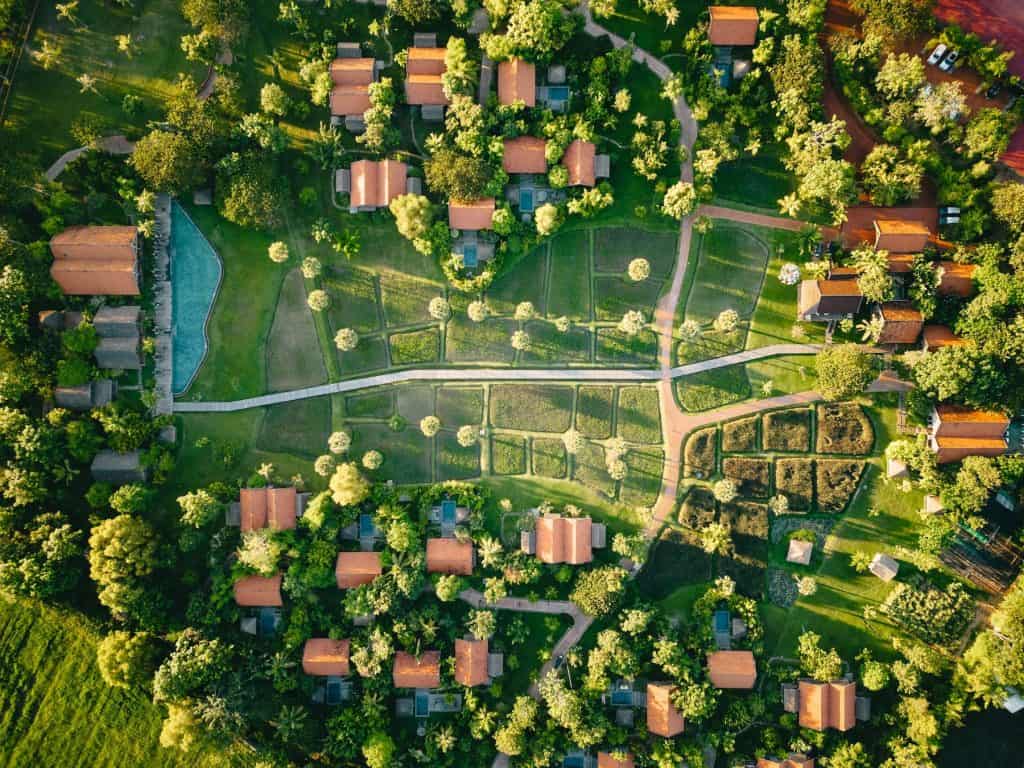
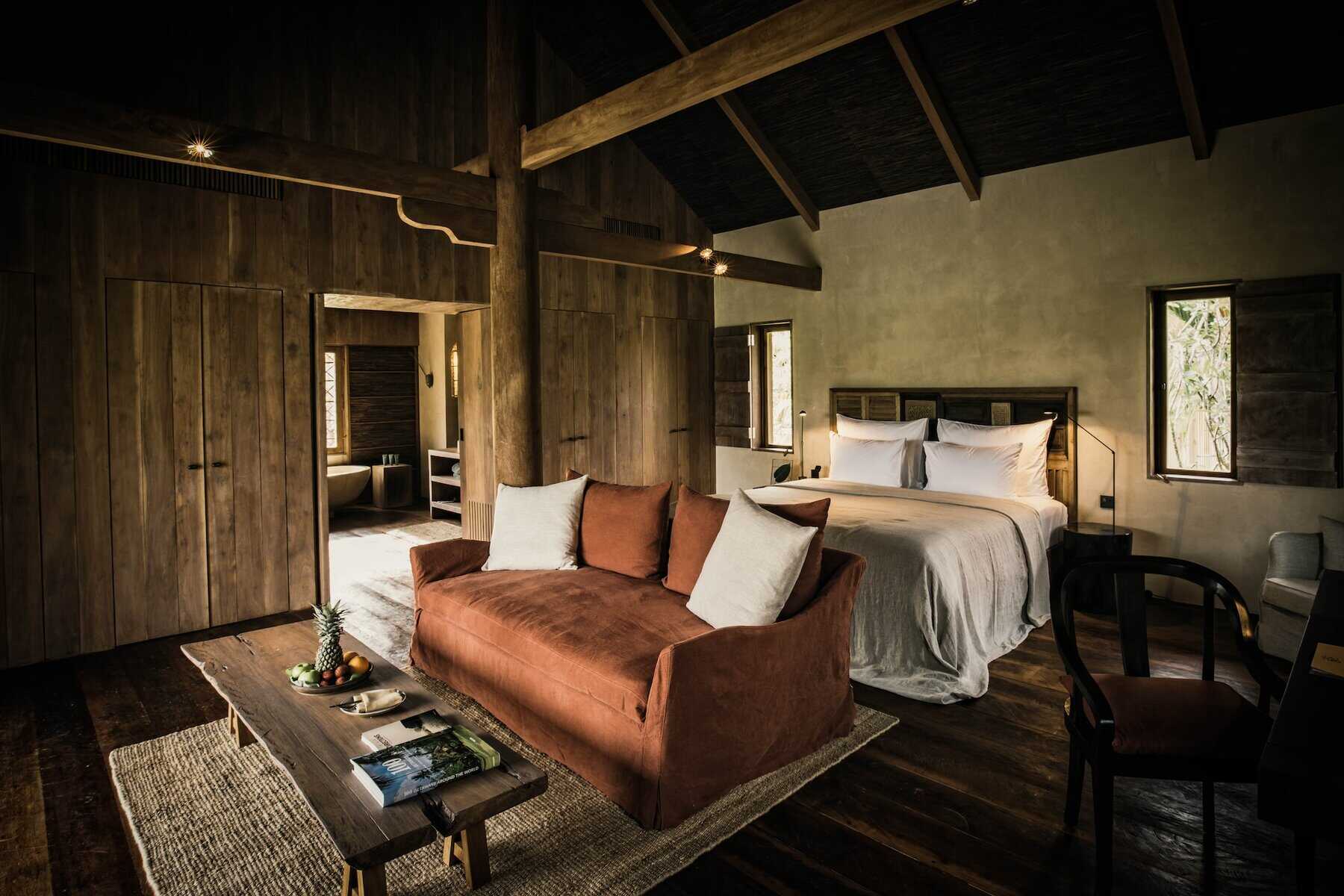
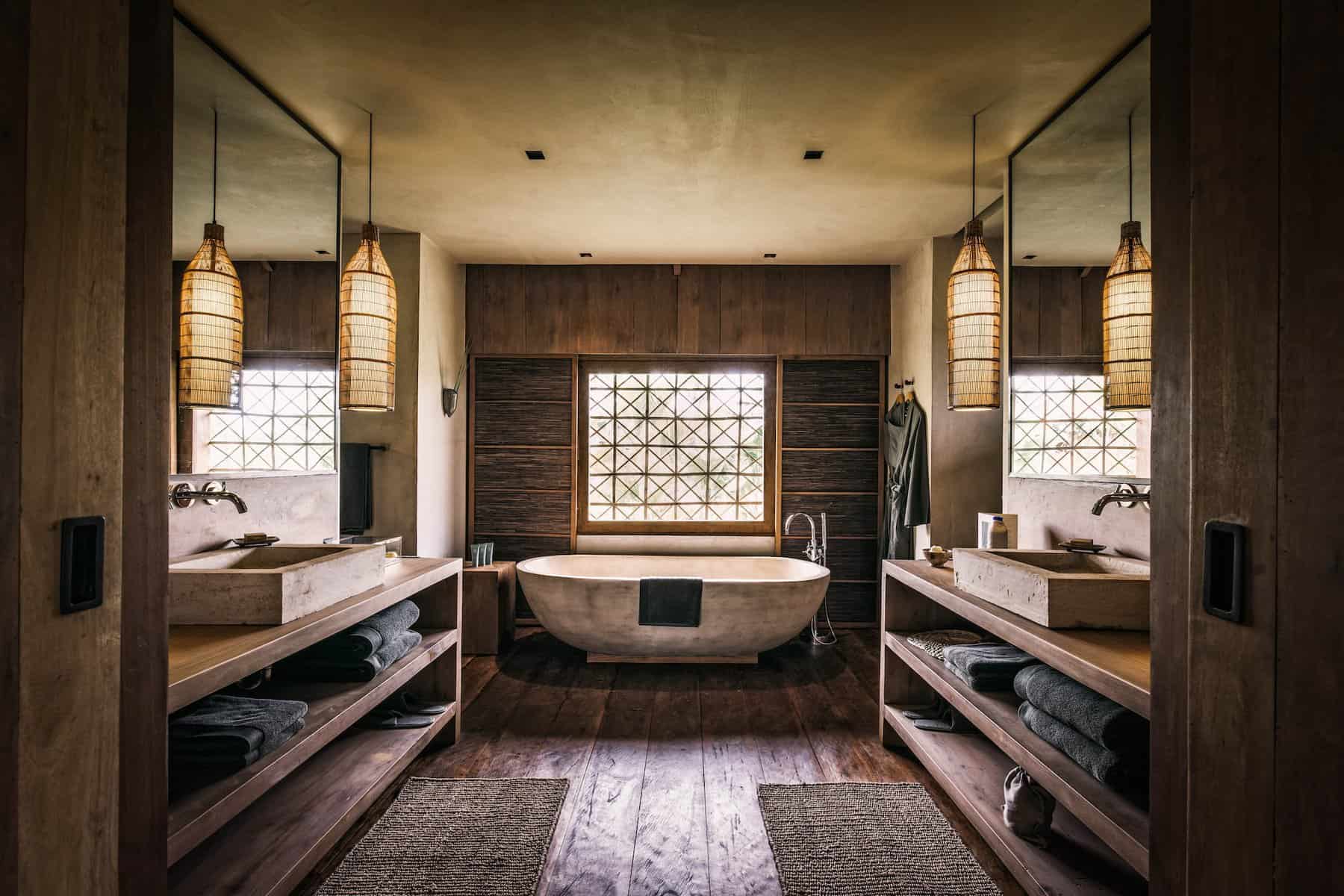
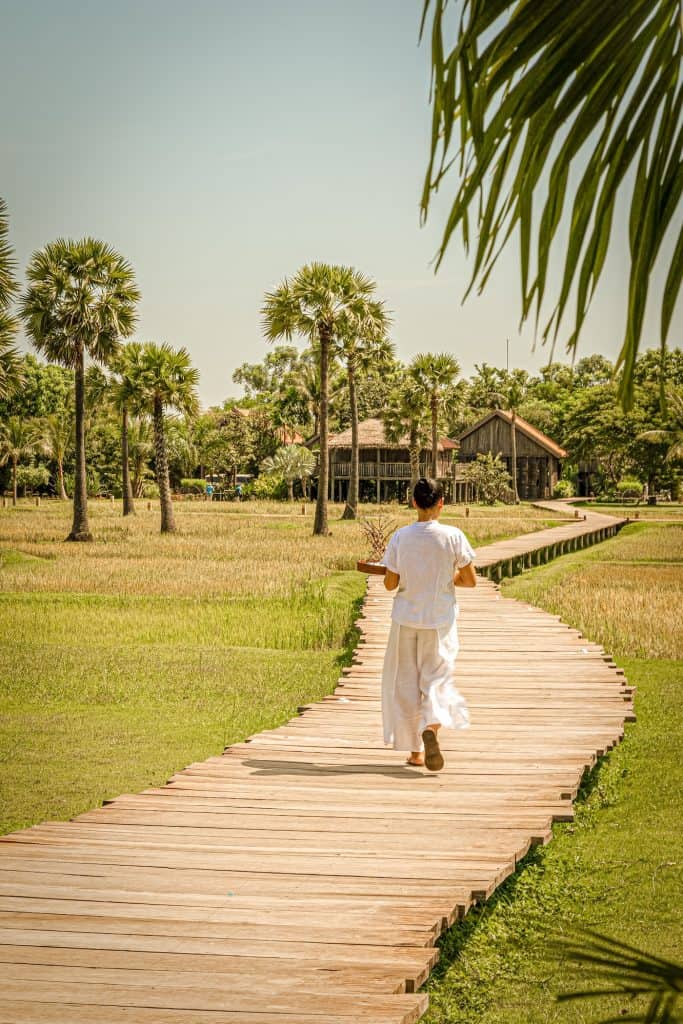
SUITES: Zannier’s 45 stilted villas are styled on traditional Khmer farmhouses. They’re outwardly authentic with sumptuous interiors blending Asian and European design. Terrace Villas (80m2) have shady decks, perfect for reading and relaxing between temple visits. Pool Villas (130m2) come with a private garden and plunge pool. Both feature high ceilings, king-size beds, and comfy Belgian sofas, alongside all of the accoutrements you’d expect in a luxury hotel. Bathrooms are large and tactile, with soaking tubs, hand-carved stone basins and organic Phum Baitang toiletries. Attention has been paid down to the smallest detail: tiny handles on rustic timber joinery and gorgeous shutters, the waxed sheen of wide floorboards, lighting layered to perfection.
SPACES: A wooden path cuts through rice paddies from the reception pavilion to the 50-metre infinity pool, hamlets of guest villas either side. Extensive menus at two restaurants—hearty Khmer dishes like amok (steamed fish) at the open-air Bay Phsar and Hang Bay for fine dining—are perfect for late lunches and cosy suppers, a dazzling wine list to boot. Spa Temple draws inspiration from the architecture of Angkor Wat, with seven treatment rooms for indigenous healing therapies alongside a yoga pavilion and fully equipped gym. There’s also a concept store, with local craft alongside fashion from Europe, Brazil and Cambodia—and a 100-year-old Khmer farmhouse that now forms the Sunset Lounge, where rattan wing chairs, oriental carpets and quirky collections of artifacts recall Cambodia’s colonial past. They’re the priciest cocktails in all of Siem Reap, but with its views across the rice paddies, there is no better spot for sundowners.
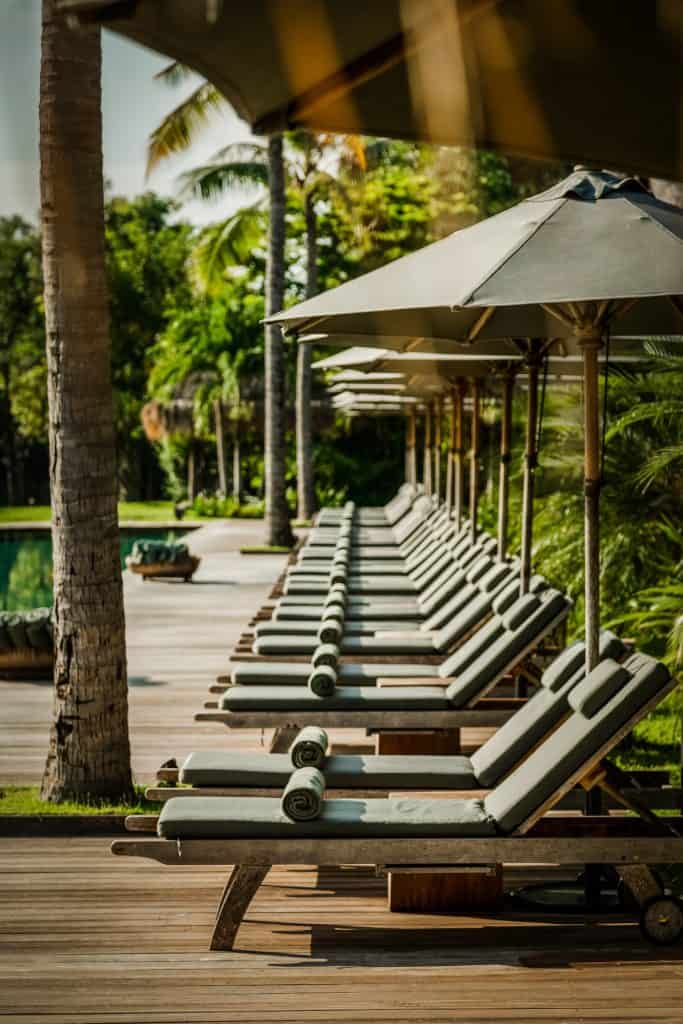
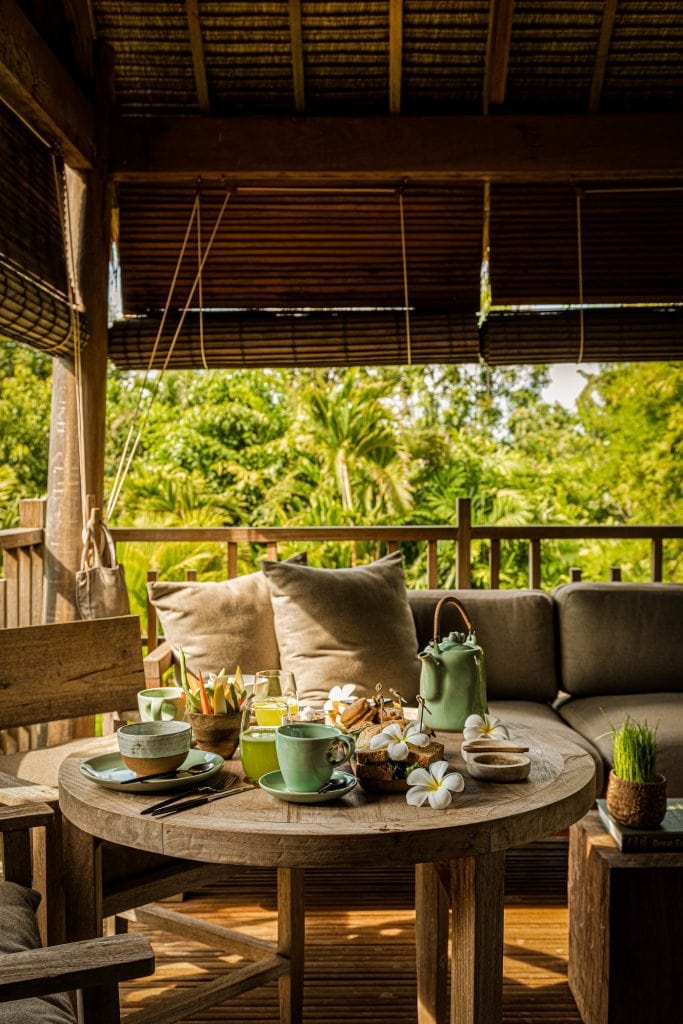
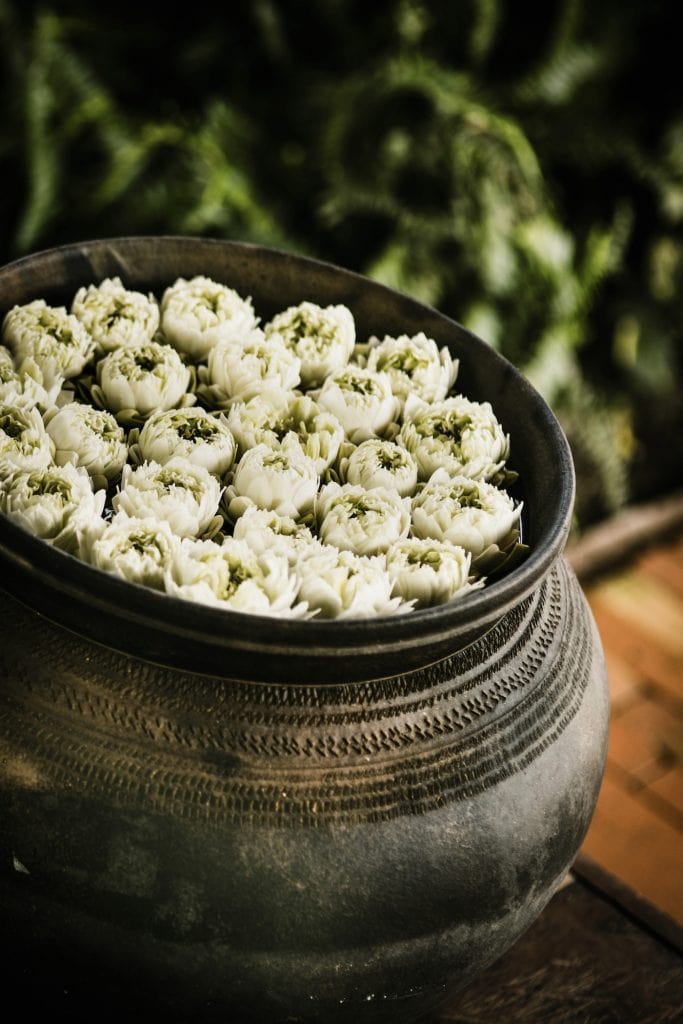
SERVICE: Staff are young, friendly and efficient. From reception to restaurants, the bar staff mixing sundowners, smiling housekeepers and gardeners in do’un farm hats working Phum Baitang’s bucolic surrounds, service was superb across the board.
SUSTAINABILITY: Phum Baitang was the first hotel in Cambodia to be certified by Green Globe, acknowledged for its sustainable initiatives. Rice and other fresh produce is grown onsite—for both restaurants and the staff canteen, the surplus going to a local orphanage—while bicycles are free to use on the resort grounds. Much attention is paid to waste through recycling, composting and converting cooking oil into biofuel. All guest villas are now plastic free.
SPEND: Terrace Villas from USD410/night, Pool Villas from USD550/night.
